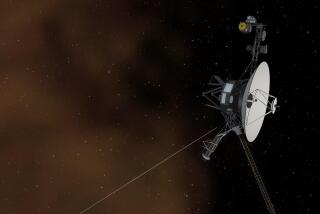Curiosity rover broadcasts message from Mars
The Curiosity rover has tested its nose and cleared its throat, and is set to start its journey toward its first potential drilling target over the coming days, scientists and engineers at the Jet Propulsion Laboratory said Monday.
In a message broadcast from the Mars Science Laboratory rover at its landing site in Gale Crater, NASA Administrator Charles Bolden congratulated the mission team in La Cañada-Flintridge on the successful Aug. 5 landing.
“This is an extraordinary achievement,” Bolden said in the recording (originally sent to the rover from Earth). “Landing a rover on Mars is not easy. Others have tried; only America has fully succeeded.”
The scientists displayed new images of the rover’s ultimate target: the base of Mount Sharp, a 3-mile-high mound in the middle of Gale Crater that scientists believe holds a record of the planet’s history, and potentially even some of the ingredients for life.
Mount Sharp’s base features well-defined layers in patterns reminiscent of the Grand Canyon, project scientist John Grotzinger said Monday at a news conference.
“That’s what I’m talking about,” Grotzinger said, indicating the watercolor layers.
The team also tested part of the rover’s Sample Analysis at Mars instrument, which can digest and analyze rock, and found it was in good working order.
Some scientists had a brief moment of shock in testing the instrument, said the instrument’s principal investigator, Paul Mahaffy, when the instrument inadvertently tested some residual gases from Earth instead of the Martian atmosphere.
“It really led to some excitement,” Mahaffy said, to laughter from the audience. When the rover’s instruments reported a higher-than-usual concentration of methane, he pointed out, “their eyes were wide open. ”
After making a short drive Monday, Curiosity is now also set to test one of the scours inadvertently dug out by the jets from the spacecraft’s landing engines when the rover touched down. Scientists will get a look at what lies underneath Mars’ surface without having to drill for it.
The rover will start driving to its first potential drill target – Glenelg, a spot 1,300 feet away where three types of terrain meet – in the coming days.
Follow me on Twitter @aminawrite.







